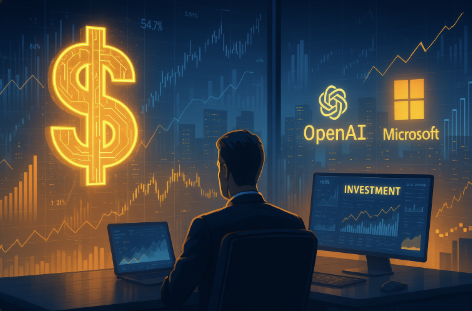Behind the Scenes of AI Hype: Who's Making Billions?

In the frenzied landscape of artificial intelligence, fortunes are being made at breakneck speed while hype and reality blur together in a high-stakes game of technological promise. As AI transforms from buzzword to business imperative, a select group of players are amassing extraordinary wealth—often behind the scenes of the technologies we're all talking about.
The Hardware Kingmakers: Nvidia Leads the Pack
At the foundation of the AI gold rush sits Nvidia, a company that transformed from a gaming graphics card manufacturer into the essential backbone of AI infrastructure. In 2023, Nvidia's market cap surged past $1 trillion, with their specialized GPUs becoming the most coveted chips in tech. "Every AI model, every data center running these large language models needs our chips," explained Jensen Huang, Nvidia's leather-jacket-clad CEO, whose 4% ownership stake in the company is now worth over $40 billion. The numbers tell the story: Nvidia's revenue jumped 101% year-over-year in Q2 2023, with data center revenue—primarily driven by AI—growing 171% to $10.32 billion. The company that once made graphics cards for gamers now provides the computational foundation for virtually every major AI system being built. But Nvidia isn't alone in the hardware bonanza. AMD has positioned itself as a formidable challenger with its MI300 AI accelerators, while Intel struggles to catch up. Meanwhile, custom AI chip development has become a priority at tech giants like Google (with its TPUs) and Amazon (with its Trainium and Inferentia chips).
The Model Makers: OpenAI, Anthropic, and the Race for Foundation Models
While hardware provides the foundation, it's the AI models themselves that capture public imagination—and investor dollars. OpenAI, once a nonprofit research lab, has become the face of generative AI with its GPT models and ChatGPT platform. Microsoft's $13 billion investment into the company valued it at approximately $80 billion by late 2023. OpenAI CEO Sam Altman, who briefly lost and then regained his position in a dramatic corporate saga, has become the de facto spokesman for AI's potential. "We're seeing the biggest platform shift in technology since the smartphone," Altman proclaimed at a Senate hearing, simultaneously stoking excitement and concern about AI's trajectory. Not far behind is Anthropic, founded by former OpenAI researchers and backed by $4 billion from Amazon and Google. The company's Claude AI assistant competes directly with ChatGPT, with both companies racing to develop increasingly capable models. The financial dynamics are staggering: building and training foundation models costs hundreds of millions of dollars, creating a high barrier to entry that only well-funded players can overcome. This has led to a concentration of power among a handful of companies with the resources to compete.
The Cloud Giants: Microsoft, Google, and Amazon Monetize the Infrastructure
Behind every AI startup sits a cloud provider, quietly collecting billions in compute fees. Microsoft Azure, Google Cloud, and Amazon Web Services have positioned themselves as the essential platforms for AI development, offering specialized infrastructure and integration with popular AI tools. Microsoft has emerged as perhaps the most aggressive AI investor, not only through its OpenAI partnership but by integrating AI capabilities across its product lineup. The strategy has paid dividends, with Microsoft's market cap surpassing $3 trillion in early 2024. "AI is the new electricity," declared Satya Nadella, Microsoft's CEO, "and cloud is the generator that powers it all." Google, despite its early lead in AI research, found itself playing catch-up in the generative AI race. The company has since invested heavily in its Gemini models and cloud AI services, while trying to protect its search business from AI disruption. Amazon, meanwhile, leverages AWS to monetize the AI boom regardless of which companies ultimately succeed. "We don't need to pick winners," explained an AWS executive who requested anonymity. "We make money when startups train their models, when they deploy them, and when they scale."
The Venture Capital Frenzy: Speculative Billions Flow Into Startups
Behind the major players sits a vast ecosystem of AI startups attracting unprecedented venture capital. In 2023 alone, AI startups raised over $40 billion in funding, with valuations often reaching unicorn status ($1 billion+) before generating meaningful revenue. Sequoia Capital, Andreessen Horowitz, and Tiger Global Management have led the charge, each deploying billions into AI ventures. These investments often come with sky-high valuations that reflect potential rather than current financial performance. "We're in a period where the normal rules of startup valuation don't apply," explained Sarah Guo, founder of Conviction, an AI-focused venture fund. "Investors are paying for option value on what could be transformative technology." This speculative fervor has created a feedback loop of hype and investment. Startups pitch themselves as AI companies to secure funding, while investors compete to back anything with AI in the pitch deck, driving valuations higher and reinforcing the narrative of an AI revolution.
The Hidden Beneficiaries: Data Providers, API Middlemen, and Talent
Beyond the headline-grabbing companies, a quiet ecosystem of beneficiaries has emerged:
Data Providers
Companies like Scale AI and Surge AI have built billion-dollar businesses by providing the human-labeled data essential for training AI models. Scale AI reached a $7.3 billion valuation in 2023 despite operating largely out of the spotlight.
API Infrastructure
Companies building the connective tissue between AI models and applications are seeing explosive growth. Weights & Biases, which provides ML development tools, reached a $4.5 billion valuation in 2023.
AI Talent
Perhaps no group has benefited more directly than AI researchers and engineers. Compensation packages at leading AI labs now routinely exceed $1 million annually for top talent, with researchers who published influential papers commanding even higher premiums. "We're seeing compensation that makes even traditional tech salaries look modest," noted Clement Delangue, CEO of Hugging Face. "A PhD in machine learning is practically a license to print money right now."
The Influence Economy: How Hype Is Manufactured and Monetized
The AI narrative isn't shaped by technology alone. A sophisticated ecosystem of influencers, analysts, and media outlets amplifies the promise while often downplaying the limitations. Tech influencers on platforms like Twitter and YouTube generate millions in revenue by producing content about AI breakthroughs, often through sponsorships from the very companies they cover. The line between objective analysis and promotion has blurred, creating an environment where critical perspectives struggle to break through. "There's more incentive to be bullish than bearish," explained one prominent tech newsletter writer who requested anonymity. "If you're excited about AI, you get invites to exclusive demos, speaking opportunities, and investment access. If you're skeptical, you get attacked and excluded." Industry conferences have become another hype machine, with events like OpenAI DevDay and Microsoft Build commanding premium sponsorship packages that turn technical showcases into marketing spectacles.
For Business Owners: Where Are the Real Opportunities?
For Canadian and US business leaders watching the AI gold rush, the key question remains: where are the genuine opportunities amid the hype? 1. Vertical AI Applications While horizontal AI platforms attract the most attention, the real business value often lies in specialized AI solutions for specific industries. Companies like Viz.ai (healthcare imaging) and Harvey (legal AI) are building sustainable businesses by focusing on discrete, high-value problems. 2. AI Implementation Services As enterprises struggle to deploy AI effectively, consulting firms specializing in AI implementation have seen surging demand. Firms like Element AI (acquired by ServiceNow) built valuable businesses by bridging the gap between AI research and practical business applications. 3. Efficiency Plays For many businesses, the most immediate AI opportunity isn't creating new products but enhancing existing operations. Companies using AI to reduce customer service costs, optimize pricing, or streamline logistics are seeing measurable ROI without betting on speculative breakthroughs. "The companies making real money today aren't necessarily building groundbreaking AI," explained Matthew Turck, partner at FirstMark Capital. "They're solving concrete business problems with proven technology."
For Consumers: Separating Value from Marketing
As AI capabilities are increasingly embedded in consumer products, distinguishing genuine innovation from marketing becomes crucial: 1. Subscription Creep Many traditional software products now come with "AI features" that justify subscription price increases. Adobe's Firefly generative AI tools, for instance, are only available in the company's more expensive subscription tiers. 2. Data Privacy Concerns The free AI tools consumers embrace often monetize user data and interactions. As Claude CEO Dario Amodei acknowledged, "Every conversation with our AI is potentially training data that makes our models more valuable." 3. Real Productivity Gains Despite the hype, some AI tools do deliver meaningful value. Tools like GitHub Copilot have demonstrated measurable productivity improvements for software developers, while image generation tools have created new possibilities for creative professionals.
The Sustainability Question: Is the AI Gold Rush Built to Last?
As billions flow into AI, questions about the sustainability of current business models loom large. The cost of training and running advanced AI models remains extraordinarily high, with OpenAI reportedly spending over $700,000 daily just to run ChatGPT. "Everyone's racing to build bigger models and more impressive demos," noted Emad Mostaque, founder of Stability AI, "but few have figured out sustainable unit economics." This has created a dependency on continuing investor funding that may prove vulnerable if market conditions change. Should interest rates rise significantly or technology stocks face broader corrections, the runway for pre-profitability AI companies could shorten dramatically.
Conclusion: Beyond the Hype Cycle
The AI gold rush has created unprecedented wealth for a select group of companies and individuals positioned at the center of the ecosystem. Hardware manufacturers, cloud providers, and well-funded AI labs have captured the majority of financial benefits thus far, while smaller players and consumers navigate a landscape of both opportunity and exaggerated promises. For business leaders, the key insight may be that sustainable AI value comes not from chasing the cutting edge, but from pragmatic applications of proven technology to specific business problems. The companies generating real returns aren't necessarily those making headlines, but those quietly deploying AI to enhance efficiency, reduce costs, and improve customer experiences. As the market matures, expect a gradual shift from speculative investment to sustainable business models, with winners determined not by who generates the most impressive demos, but by who creates measurable value for customers willing to pay for it. The gold rush will eventually give way to a more sustainable ecosystem—but not before creating a new class of tech billionaires and reshaping the competitive landscape of technology for decades to come.
